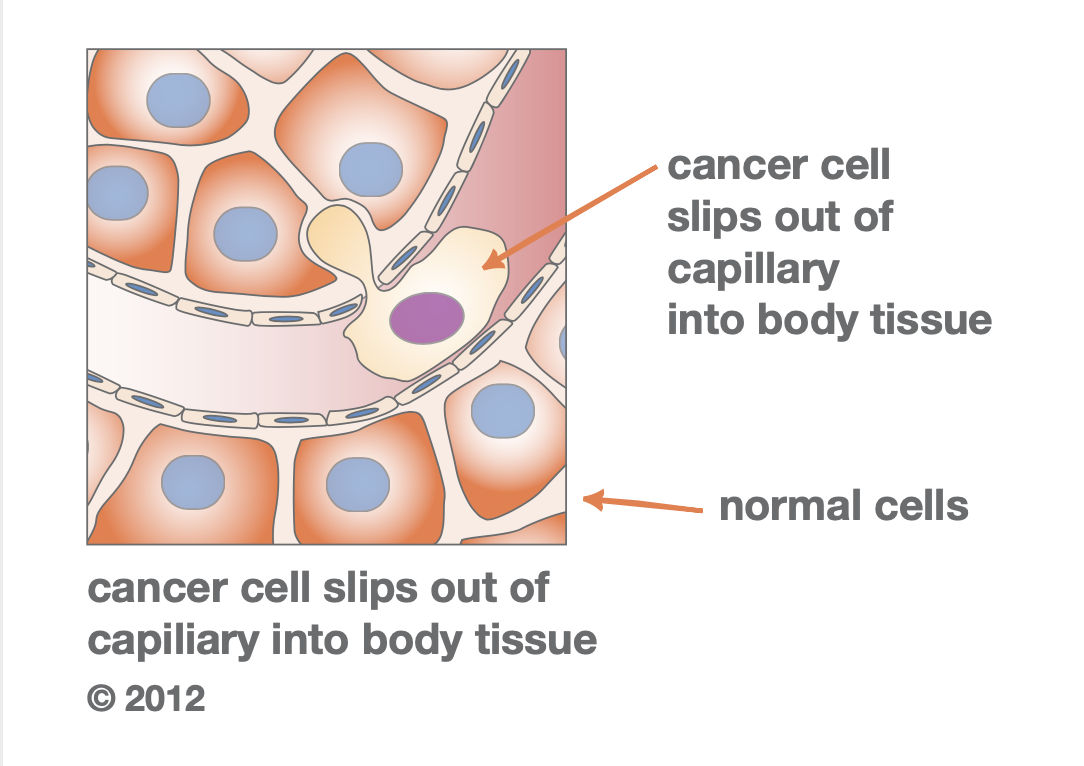THE LYMPHATIC AND VASCULAR SYSTEM AND THEIR ROLE IN METASTATIC SPREAD.
by Morag Currin
The spread of malignant cells into the lymph nodes can move slowly or fast. This depends on the tumor, and once these malignant cells position themselves in the lymph nodes a few things can happen. They can die due to a local inflammatory reaction; they can wither and die due to an unsupportive environment; they can grow into a mass; or they can just remain dormant.
It is logical to believe (based on physiology) that nearby lymph nodes that drain the primary tumors would test positive before distant nodes would, but there are times where metastatic cells will bypass the local lymph nodes and settle in distant ones. It is suspected that ‘site specific recognition’ plays a part in where these cancers are found.
It is now known that tumors are able to form new lymph vessels. The formation of lymph vessels (lymphangiogenesis) is stimulated by a protein called the vasoendothelial growth factor C. The formation of new vessels will facilitate the spread of cancer to nearby lymph nodes. The local spread of cancer occurs mostly through lymph vessels.
The spreading of cancer cells to remote vital organs and tissues is mostly via the bloodstream and the spread of cancer cells to vital organs are the most detrimental. Tumor cells that enter the blood will circulate until they are killed off; or they are trapped in the capillary bed or another organ, or they invade the blood vessel wall into the tissue of a distant organ. The cancer cells that remain in the bloodstream are trapped inside the tiny vessels of a capillary bed usually die within a couple of hours. A very small number of migrating cancer cells that enter the bloodstream will live to reach another organ, let alone position themselves at a new site due to all the body’s immune system controls that keep normal cells in check. Due to the constant process of cancer cells trying to migrate, some metastatic growths can eventually form.
When cancer cells are in the blood, they also are faced with threats to survive, such as mechanical forces of blood turbulence. Hemodynamics (physical factors that govern blood flow), vascular pressure and flow rate may be too high in areas for cancer cells to rest such as in the skin. Cancer cells are smart and can also adhere to other cells which protect them from the circulating immune cells that are looking for them in order to destroy them. It is also apparent now that cancer cells can adhere to blood cells, particularly platelets. Since platelets have their own growth factors it is these same growth factors that may be helping cancer cells to survive!
Once a tumor cell embolus (unattached mass) has arrested (stops), the following sequence of events happens in order for them to survive.
- The tumor cell mass adheres to endothelial lining
- The tumor cell mass invades the wall to pass through the basement membrane surrounding tissue or organ.

More On Metastasis
Metastatic cells must invade that protective wall (directly through thin-walled capillaries, or by producing enzymes that degrade the basement membrane). Degradation of the basement membrane damages the tissue, which in turn stimulates an inflammatory response. Prostaglandins, one of the substances released during the inflammatory process causes vasodilation, which increases the permeability of the affected vessels. Cancer cells use these leaky vessels and subsequent creation of an inflammatory reaction at the site to further escape from the vascular system.
Once cancer cells invade distant tissue, they may die; lie dormant for years and then grow to a large size long after a primary tumor has been removed, or they may begin growing to a large size immediately.
It is not known what causes cancer cells to remain in a dormant stage or what may trigger them into activity.
The final ability needed to create new growth for the tumor is for it to establish its own blood supply. Metastatic cells send a chemical message to the host tissue which stimulates growth. Without its own blood supply (angiogenesis), the tumor will wilt and die after a short period of time
Metastatic cells must invade that protective wall (directly through thin-walled capillaries, or by producing enzymes that degrade the basement membrane). Degradation of the basement membrane damages the tissue, which in turn stimulates an inflammatory response. Prostaglandins, one of the substances released during the inflammatory process causes vasodilation, which increases the permeability of the affected vessels. Cancer cells use these leaky vessels and subsequent creation of an inflammatory reaction at the site to further escape from the vascular system.
Once cancer cells invade distant tissue, they may die; lie dormant for years and then grow to a large size long after a primary tumor has been removed, or they may begin growing to a large size immediately.
It is not known what causes cancer cells to remain in a dormant stage or what may trigger them into activity.
The final ability needed to create new growth for the tumor is for it to establish its own blood supply. Metastatic cells send a chemical message to the host tissue which stimulates growth. Without its own blood supply (angiogenesis), the tumor will wilt and die after a short period of time.
All Of Morag’s Articles
Morag Currin is a monthly featured guest blogger. She has an entire library of content on Oncology Aesthetics® here at Lipgloss + Aftershave.
Watch Webisode of L+A Now with Morag, “Preview Of Full Day Workshop” on Oncology Aesthetics®

Watch The Episode On The L+A App!
Download on the App Store or Google Play

About Morag
As a leader in our industry, Morag has spent over 27 years in the aesthetic/skin care industry, researching and constantly updating her knowledge on cancer and other diseases and how treatment affects the services we offer; plus she still offers services such as reflexology, aromatherapy and electrodessication. Morag pioneered Oncology Esthetics® training back in 2007. It was her concept that has driven change to our industry that others have followed. She consults globally with industry leaders by educating them how to include the cancer community. Besides making time for written articles and webinars she offers equine facilitated learning and activity sessions for the cancer community and veterans since there is a prevalence of significant psychological distress within these communities.
